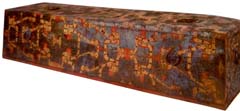

History of Chinese Invention - The Invention of Lacquer |
Lacquer is a fast-drying, hard, high-gloss surface coating. These varnishes are made by dissolving a cellulose derivative and modifying materials in a solvent and adding pigment if desired. China's history of making lacquer ware may be as old as the Neolithic Age. During the Shang Dynasty, (1600-1046 BCE), a coating made from the sap of a sumac variety tree, Rhus verniciflua had unusual and useful qualities. It can be applied in successive layers to wooden, bamboo, and metal objects, such as dishes and boxes, and each layer can be hardened by exposure to moisture to oxidize the coating. The resulting surface is hard and impermeable and can be polished, colored, or delicately carved to reveal the successive layers beneath.
Archaeological finds have confirmed the use of sophisticated lacquer objects in China dating back to 772 BCE and the Warring States period (481-221 BCE). In 1976 archaeologists recovered some samples of red lacquer around Anyang near Yinxu in Henan province, the last Shang dynasty capital city. Excavations uncovered a burial pit near the main royal cemetery. The tomb has been dated to around BCE 1200 and identified, from ritual bronze inscriptions, to be that of Lady Fu Hao, one of the wives of the Shang King Wu Ding. Her relatively small tomb is one of the best-preserved Shang Dynasty royal tombs and the only one not to have been looted before excavation. Inside the pit a wooden chamber contained a lacquered wooden coffin that has since completely rotted away.Other excavations of royal tombs showed that the chambers contained painted lacquer coffins, sometimes inlaid with ivory and turquoise.
 The image on the right shows a Chinese lacquered coffin from the ancient State
of Chu, dated to the 4th century BCE. This coffin is actually the innermost of
three nested coffins. The sides and top are decorated with seventy-two
interlaced serpentine dragons and mythical birds. (From the Hubei Provincial
Museum, image provided under terms of the GNU Free Documentation License,
published by the Free Software Foundation).
The image on the right shows a Chinese lacquered coffin from the ancient State
of Chu, dated to the 4th century BCE. This coffin is actually the innermost of
three nested coffins. The sides and top are decorated with seventy-two
interlaced serpentine dragons and mythical birds. (From the Hubei Provincial
Museum, image provided under terms of the GNU Free Documentation License,
published by the Free Software Foundation).

The National Palace Museum of Taipei dates some lacquerware in its collection to over 3,000 years old. A wood-based red lacquer bowl displayed in the Provincial Museum of Zhejiang was unearthed in Che-chiang province in 1978, and is dated 6,000-7,000 years old.
This technique of lacquering, adopted in Korea and then Japan by the 6th century AD, provides one of the most highly valued commodities of the orient. In later years, an notably duirng the Ming Dynasty (early in the 17th century) many exquisite objects, such as lacquerware boxes, became treasured trade objects.
The earliest-known pieces of East Asian lacquer in the West (Innsbruck, Schloss Ambras) are five small Chinese bowls and a Japanese cabinet in the collections of Archduke Ferdinand of Austria, who reigned 1564-1595. The word lacquer is rooted in the term "lac" from a beetle species, Coccus lacca. The insect secreted the natural substance Lac which is processed for further use in lacquers (such as shellac). The lacquer art form was copied by artisans in the West in a process called japanning, and by the 18th century high quality art was produced widely over Europe and Russia.
Maque lacquerware of the Americas
Uruapan in Michoacán is considered the cradle of Central American lacquerware known as maque. Together with other centers in Chiapas and Guerrero, Maque art flourished long before European contact. The lacquerware similar to Chinese style in Michoacán probably dates from between the 8th and 12th centuries, when a wave of cultural innovations appeared in Michoacán along with metallurgy and a new ceramic style.Some accounts suggest an earlier introduction by the Buddhist monk, Hui Sheng, who in 458 AD led a group of monks on a voyage to the land of cactus. Hui Shen returned to China 41 years later, and reported his findings to the Xiao kingdom of the Qi state. Other speculations build a case for the Chinese reaching the west coast of Mexico in the 7th century AD, but there appear to be no scholarly consensus on China's contact with Pre-Columbian civilizations.
Lacquerware in Asia, today and yesterday
edited by Monika Kaplan
UNESCO Publishing, 2002The Genius of China
3,000 Years of Science, Discovery and Invention
written by Robert K.G. Temple and published by Simon and Schuster, 1986
Currently out-of-printNeedham, Joseph
Science and Civilisation in China
17 vols. published of 25 projected.
Cambridge
Cambridge University Press, 1954-1995.
[For the titles of the single volumes see the home page of
Science and Civilisation in China, The School of Oriental and African Studies (SOAS)
University of London
http://www.soas.ac.uk/needham/SCC
See also the website of the Needham Research Institute.
http://www2.soas.ac.uk/needham/NRI
Document from The British Museum, The tomb of Lady Fu Hao
http://www.ancientchina.co.uk/staff/resources/background/bg7/bg7pdf.pdf
Buckley Ebrey, Patricia. "Shang Tomb of Fu Hao"
A Visual Sourcebook of Chinese Civilization. University of Washington
http://depts.washington.edu/chinaciv/archae/2fuhmain.htm
Retrieved August 4, 2007
Shang civilization, Web pages
http://www.jrank.org/history/pages/5999/Shang-Civilization.html
Retrieved February 10, 2009
Zhejiang Provencial Museum, Web pages
http://www.zhejiangmuseum.com/collect.do?status=detail&cid=34
Retrieved February 22, 2010